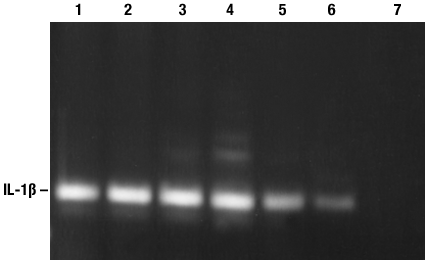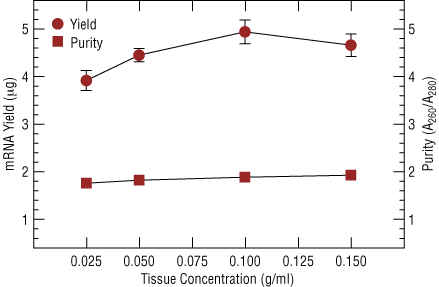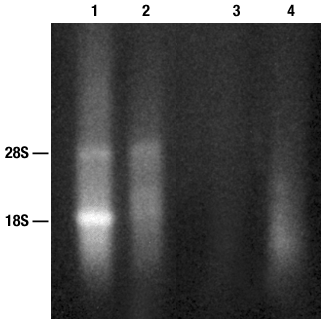





Index: Volume 1 Number 2
Next Article: Specificity of Solid Phase RT-PCR
 |
mRNA Purification
The efficient isolation of pure and intact messenger RNA (mRNA) is essential for the study of gene expression. High yield and purity of the mRNA isolated is especially critical when studying poorly expressed species. Many different techniques have been developed to isolate pure mRNA. Most of these procedures require first isolating total RNA using methods that disrupt cells and inactivate RNase simultaneously1-3 followed by selection of polyadenylated RNA by affinity chromatography on oligo(dT)-cellulose4-5. In this report we examine the use of PureBiotech LLC's magnetic porous glass (MPGŪ Streptavidin*) technology for isolation of pure, intact mRNA directly from cells or tissue. This 20 minute method bypasses the need for total RNA isolation prior to enrichment of mRNA.
Rapid Isolation of pure, intact mRNA
Isolation of mRNA was completed in a single tube by hybridizing the polyadenylated RNA directly from tissue lysates to oligo(dT)25 -bound magnetic particles. Protocols utilizing both lithium chloride- and guanidine isothiocyanate- based homogenization buffers were compared. The isolated mRNA was then analyzed for yield, purity and integrity by spectrophotometry, gel electrophoresis and ultimately solution phase RT-PCRb (Figure 1). Studies were carried out using the MPGŪ Direct mRNA Purification Kit (MDRK1010) containing lithium chloride-based homogenization buffer and the MPGŪ Guanidine Direct mRNA Purification Kit (MGRK1010) containing guanidine-based homogenization buffer.
 |
| Figure 1: Titration of mRNA template in solution phase RT-PCR. mRNA was isolated from mouse liver using the MDRK protocol. Increasing amounts of mRNA were added to the RT reaction. PCR amplification of mouse IL-1ß was accomplished using the Taq-FORCE™ DNA Amplification System. PCR products were resolved on a 1.2% agarose gel (1X TAE) and visualized by ethidium bromide staining. Lane 1, 200 ng; lane 2, 100 ng; lane 3, 10 ng; lane 4, 1 ng; lane 5, 100 pg; lane 6, 10 pg; lane 7, 1 pg. |
Optimal Conditions for mRNA Isolation
Initial studies were designed to determine the optimal concentration of tissue in homogenization buffer that would afford maximum yield and purity of mRNA using the MDRK1010 kit. Increasing amounts of mouse liver were homogenized in LiCl-based homogenization buffer and the mRNA isolated. Yield and purity of the mRNA was measured by A260 and A280. The results of triplicate samples from two different mice are shown in Figure 2. Increasing the concentration of tissue in the homogenization buffer above 0.1 g/ml reduced the yield of mRNA. Increasing the amount of oligo(dT)25 MPGŪ Streptavidin particles for isolations using greater than 0.1 g/ml concentration of tissue in homogenate did not improve these yields (data not shown). The lower yields observed at concentrations above 0.1 g/ml are caused by excess protein and cellular debris in the homogenate supernatant, impeding hybridization of the poly(A)-tailed mRNA to the oligo (dT)25. While the yield was affected by the concentration of the homogenate, the purity of the mRNA isolated was unchanged by the concentration of tissue during the hybridization step. From these results we conclude that the optimal range of concentration of tissue: homogenization buffer is 0.05-0.1 g/ml. This concentration was used for all subsequent studies of mRNA purification using the magnetic particle technology.
 |
| Figure 2: Titration of tissue used in mRNA purification. mRNA was isolated from homogenates containing increasing amounts of mouse liver on 1 mg MPGŪ Streptavidin following the MDRK kit protocol. The eluted mRNA absorbance at A260 and A280 was measured. mRNA yield ( |
Capacity of MPGŪ Streptavidin
The mRNA binding capacity of the magnetic particles was determined by isolating mRNA from mouse liver (homogenized at a concentration of 0.05 g/ml) with increasing amounts of oligo(dT)25 -bound MPGŪ Streptavidin. Figure 3 shows the results of triplicate samples from 2 different mice. The data is presented as micrograms of mRNA isolated per milligram of particles and shows a mRNA binding capacity of 4-5 µg/mg particles.
 |
| Figure 3: Titration of MPGŪ Streptavidin used in mRNA purification. mRNA was isolated from 1 ml homogenates (0.05 g tissue/ml homogenization buffer) with increasing amounts of MPGŪ Streptavidin by following the MDRK kit protocol. The eluted mRNA absorbance at A260 and A280 was measured. mRNA yield ( |
LiCl-based Homogenization Buffer vs. Guanidine-based Homogenization Buffer
Based on the optimal conditions established for hybridization, we then compared the efficacy of two different homogenization buffers to isolate mRNA from tissues with low levels of RNase (liver) and very high levels of RNase (spleen). The mRNA from mouse liver and spleen was isolated using either the LiCl-based (MDRK1010) or guanidine isothiocyanate-based (MGRK1010) kit. The yield and purity of the isolated mRNA from each sample were determined (Table 1). The eluted mRNA from each sample was run on a 1.2 % agarose-TAE gel showing the integrity of the messenger RNA (Figure 4). The yield of mRNA isolated from both the liver and spleen was greater using the MGRK protocol. The yield, as determined by absorbance at A260, from liver increased minimally using the MGRK protocol, while the mRNA obtained from spleen using the MGRK protocol increased by approximately 100% with only a slight decrease in the purity of the eluted mRNA. Sufficient yields from spleen required the use of the guanidine isothiocyanate-based homogenization buffer to inactivate the high levels of RNase released following disruption of this tissue. This result is consistent with what is expected from the greater RNase inactivating capability of guanidine isothiocyanate as compared to LiCl .
| Liver | Spleen | |||
|---|---|---|---|---|
| MDRK | MGRK | MDRK | MGRK | |
| Yield (µg): | 4.50 ± 0.710 | 5.54 ± 0.21 | 1.69 ± 0.12 | 3.22 ± 0.73 |
| Purity (A260/A280): | 2.00 ± 0.001 | 1.81 ± 0.10 | 1.93 ± 0.10 | 1.89 ± 0.06 |
Table 1: Comparison of MDRK and MGRK mRNA yield and purity. mRNA was isolated from liver and spleen, removed from the same mouse, using either the MDRK or the MGRK kit protocol. After elution, the mRNA absorbance at A260 and A280 was measured. The data is expressed as the mean ± s.d. from 6 replicate samples.
 |
| Figure 4: Electrophoretic analysis of purified mRNA. mRNA was isolated, from the liver and spleen from the same mouse, by both the MDRK and MGRK kit protocols. The eluted mRNA from each sample was run on a 1.5% agarose gel (1X TAE) and then visualized by ethidium bromide staining. Lane 1, liver/MDRK; lane 2, liver/MGRK; lane 3, spleen/MDRK; lane 4, spleen/MGRK. |
Scaleable Procedure
The amount of mRNA present in different cell populations varies between <1% to 5% of the total cellular RNA6. The differences in mRNA yields from liver, brain, kidney, lung and heart were compared using the MDRK protocol. Each tissue homogenate was prepared at a concentration of 0.05 g tissue:homogenization buffer. mRNA was isolated from 1.0 ml aliquots of tissue homogenate using 1 mg of magnetic particles. Table 2 shows the differences in the amounts of mRNA isolated from homogenates prepared from different tissues obtained from the same mouse. The yields obtained from each tissue were consistent with the amount of mRNA available in 50 mg of each tissue homogenate6.
This information is useful when determining the amount of starting material needed to study the expression of specific genes. For example, RT-PCR requires less than 200 ng of mRNA for each assay, whereas detection of a poorly expressed gene by Northern Blot analysis might require 5-10 µg of mRNA per sample. Use of the MDRK1010 kit procedure is scaleable. Increasing the amount of tissue homogenate (not the concentration of tissue in the homogenate) added to 1 mg MPGŪ Streptavidin particles, up to 4-5 µg of mRNA is isolated from each tissue. Likewise, if you require more than 5 µg of mRNA, more particles would be used in addition to more tissue homogenate to isolate the full amount of mRNA you require in one isolation.
| Liver | Brain | Kidney | Lung | Heart | |
|---|---|---|---|---|---|
| Yield (µg): | 4.01 ± 0.40 | 3.37 ± 0.27 | 3.07 ± 0.35 | 2.11 ± 0.23 | 2.05 ± 0.15 |
| Purity (A260/A280): | 1.9 ± 0.10 | 1.8 ± 0.10 | 1.8 ± 0.13 | 1.8 ± 0.10 | 1.8 ± 0.09 |
Table 2: Effect of tissue origin on mRNA yield. mRNA was isolated on 1 mg MPGŪ Streptavidin from 1 ml tissue homogenates (0.05 g/ml) dissected from the same mouse following the MDRK kit protocol. The eluted mRNA absorbance at A260 and A280 was measured. The data is expressed as the mean ± s.d. from 6 replicate samples from two different mouse preparations.
RT-PCR Analysis
To further assess the quality of the mRNA, solution phase RT-PCR was performed on liver mRNA purified using the MDRK protocol. cDNA libraries were constructed by the addition of decreasing amounts of the eluted mRNA to 50 µl reactions containing: 150 pmol oligo(dT)25; 50 mM Tris-HCl, pH 8.4; 50 mM KCl; 1 mM dithiothreitol; 50 mM MgCl2; 1.6 mM dNTP mix; 20 U RNase Inhibitor (PureBiotech LLC); and 20 U AMV Reverse Transcriptase (PureBiotech LLC). The reaction was carried out at 42°C for 1 hour. Mouse IL-1ß was then amplified by the polymerase chain reaction (PCR) using the Taq-FORCE™ Amplification System (PureBiotech LLC) in a Perkin-Elmer 2400 Thermocycler for 35 cycles (5 min., 94°C; [45 sec., 94°C; 45 sec., 60°C; 90 sec., 68°C] x 35; 7 min., 68°C). Figure 1 shows the PCR results of RT-PCR studies starting with 0.1 pg to 200 ng of mRNA in the RT reaction. IL-1ß PCR product was detectable down to 10 pg of mRNA, thus indicating high purity and quality of the mRNA isolated by the MDRK protocol.
Selecting the Correct Kit
The MGRK1010 kit is the choice for mRNA isolation from cells and tissues with high levels of RNase. The guanidine isothiocyanate-based homogenization buffer did not interfere with the poly(A) hybridization to the oligo(dT)-bound MPGŪ Streptavidin particles and resulted in increased yields (Table 1). The MDRK1010 kit is clearly the best choice for tissues with relatively low intracellular RNase content, such as liver. mRNA of consistently higher purity without compromise in yield was obtained using this lithium chloride-based protocol (Table 1).
Advantages of Direct mRNA Purification using Magnetic Technology
The use of this particle-based magnetic mRNA purification technology for the isolation of mRNA directly from tissue provides pure, intact mRNA of high quality, yield and purity in 20 minutes. This method eliminates the need for initial purification of total RNA, phenol/chloroform extractions, and ethanol precipitations. The single-tube approach prevents sample loss and potential loss of rare messages. The isolated mRNA is eluted from the magnetic particles in any convenient volume and low salt elution buffer. The mRNA can then be used directly in cDNA library construction; Northern blotting; in vitro translation; S1 nuclease analysis; sequencing; RNA and DNA binding protein isolation; specific hybridization probes; subtractive hybridization; cloning, solution-phase RT-PCR, and solid-pahse RT-PCR (refer to Specificity of SOLIDscript™).
1. Sela, M., Anfinsen, C.B., and Harrington, W.F. (1957). Biochim. Biophys. Acta 26, 502.
2. Cox, R.A. (1968). Methods Enzymol. 12B, 120.
3. Chirgwin, J.M., Przybyla, A.E., MacDonald, R.J., and Rutter, W.J. (1979). Biochemistry 18, 5294.
4. Edmonds, M., Vaughan, Jr. M.H., and Nakazato, H. (1971). Proc. Natl. Acad. Sci. 68, 1336.
5. Aviv, H., and Leder, P. (1972). Proc. Natl. Acad. Sci. 68, 220.
6. Alberts, B., Bray, D., Lewis, J., Raff, M., Roberts, K., and Watson, J.D. "Molecular Biology of the Cell", 3rd ed. (1994) Garland, New York. 364-378.
Next Article: Specificity of Solid Phase RT-PCR
© 2004-2023 PureBiotech LLC All rights reserved.